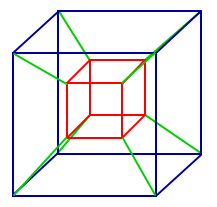Here’s a challenging problem with a surprisingly easy answer: can you show that for any 5 points placed on a sphere, some hemisphere must contain 4 of the points?
How about an easier question: can you show that if you place 5 points in a square of sidelength 1, some pair of them must be within distance 3/4 of each other?
If you play with this problem for a while, you’ll realize quickly that the extreme case occurs when 4 points are at the corners of the square with a 5th point at the center. In this case adjacent points are exactly distance Sqrt[2]/2 ~ 0.707 apart. But what may be harder to show is that this is really the extreme case; why can’t any other configuration be more extreme?
The pigeonhole principle is one of the simplest but most useful ideas in mathematics, and can rescue us here. A basic version says that if (N+1) pigeons occupy N holes, then some hole must have at least 2 pigeons. Thus if 5 pigeons occupy 4 holes, then there must be some hole with at least 2 pigeons. It is easy to see why: otherwise, each hole as at most 1 pigeon and the total number of pigeons couldn’t be more than 4. (This proof shows that it does not even matter if the holes overlap so that a single pigeon occupies 2 holes.)
So, if I divide up the square into 4 smaller squares by cutting through center, then by the pigeonhole principle, for any configuration of 5 points, one of these smaller squares must contain two points. But the diameter of the smaller square is Sqrt[2]/2, so these two points must be closer than 3/4, as claimed. The pigeonhole principle made what seemed like a slippery argument airtight.
The Math Behind the Fact:
The pigeonhole principle has many generalizations. For instance:
If you have N pigeons in K holes, and (N/K) is not an integer, then then some hole must have strictly more than (N/K) pigeons. So 16 pigeons occupying 5 holes means some hole has at least 4 pigeons.
If you have infinitely many pigeons in finitely many holes, then some hole must have infinitely many pigeons!
If you have an uncountable number of pigeons in a countable number of holes, then some hole has an uncountable number of pigeons!
Did you think about the challenge problem? Here is the answer: for any configuration of 5 points on a sphere, any two of them determine a great circle on the sphere (a circle whose center is the center of the sphere), and that great circle divides the sphere into 2 hemispheres. Considering the remaining 3 points, the pigeonhole principle says that one of the hemispheres must contain at least 2 of those 3 points. Together with the 2 points on the great circle, that hemisphere contains at least 4 points.
How to Cite this Page:
Su, Francis E., et al. “Pigeonhole Principle.” Math Fun Facts. <https://www.math.hmc.edu/funfacts>.
References:
The sphere problem comes from a recent Putnam examination.
Fun Fact suggested by:
Francis Su

